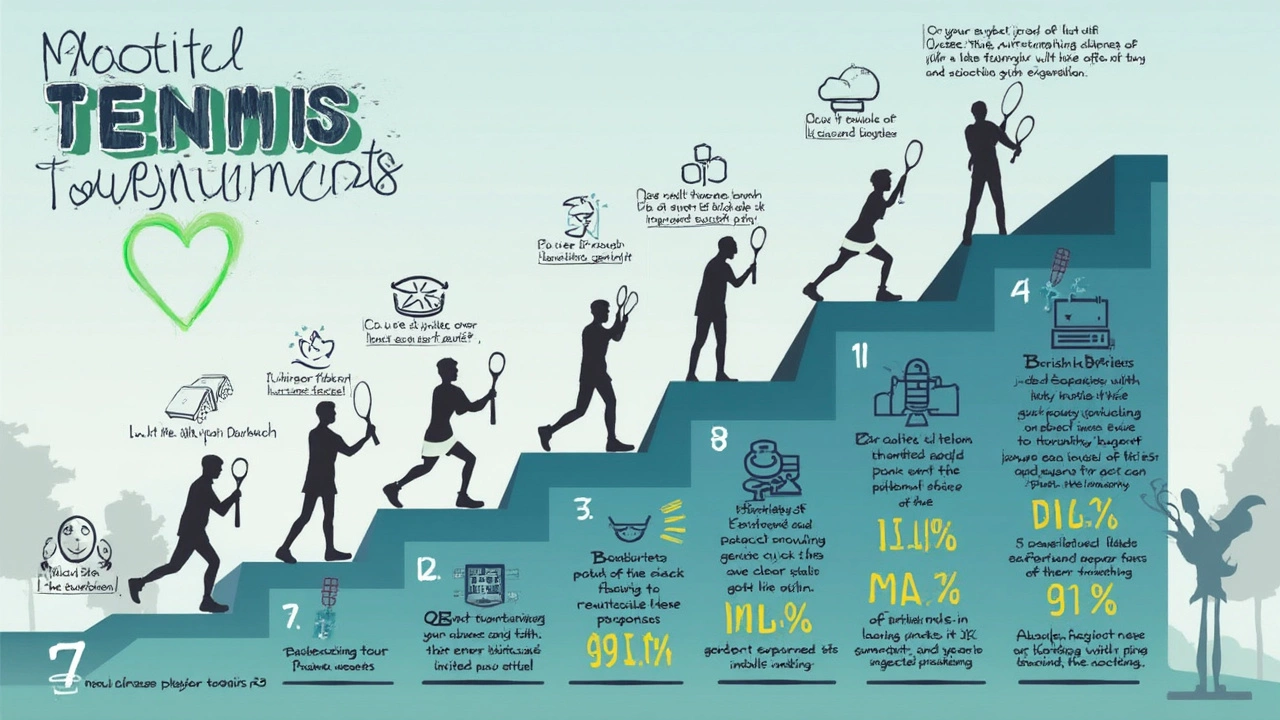If you've seen 'L7' listed next to a tennis tournament, you're not alone in scratching your head. This label pops up a lot, especially if you're checking tournament calendars or trying to figure out which event suits your skill level or your kid’s progress.
'L7' isn’t some secret code, but it’s way more meaningful than it first looks. In USTA-sanctioned events in the US, 'L' stands for ‘level’—a quick way to show how advanced and competitive a tournament is. L7 is on the lower end of the official scale, but that doesn’t make it pointless. Far from it. For players just starting to try competitive matches, or for kids like my son Finn dipping a toe into the world of rankings, L7 is usually where you get your first real taste of tournament play.
So why use a number system? It helps standardize tournaments across different states and organizers. If you show up to any event labeled L7, you’ll know what to expect—less pressure, easier entry, and more focus on learning than cut-throat competition. For parents and coaches, this little code quickly tells you if an event matches a kid’s experience level or if jumping straight to L3 might be biting off more than you can chew.
- Where Did 'L7' Come From?
- Breaking Down Tennis Tournament Levels
- What Does L7 Mean for Players?
- How L7 Tournaments Impact Rankings
- Pros and Cons of Playing L7 Events
- Tips for Choosing the Right Tournament Level
Where Did 'L7' Come From?
You might think 'L7' is just some random tag, but there's real logic behind it. The numbering system for tournament levels actually got its start in the US with the United States Tennis Association (USTA). Before 2021, junior and adult tournaments had complicated names and little consistency. A local singles tourney in one state might have a totally different system than one a few miles away. It frustrated a lot of parents and players. To fix this, the USTA rolled out a national-level coding: L1 is the top level and L7 is the entry point. This change made the process way more transparent, especially for families hopping between tournaments.
Here's what the levels mean in the USTA's current system:
- L1: National Championship or top-level event
- L2 to L6: Decreasing in points, size, and experience needed
- L7: Lowest entry level—local, friendly events with easy sign-up
According to the USTA, "The new level-based pathway is about opening up opportunities, not making competition more exclusive."
USTA says, "Our goal is to help players and parents quickly identify which tournaments fit their needs, and make the system easier to understand for everyone involved."
L7 events exploded in popularity, especially after the change. In 2023, for example, more than 28,000 junior players competed in at least one L7 event, according to the USTA's participation report.
| Year | Players in L7 Events |
|---|---|
| 2021 | 19,870 |
| 2022 | 24,350 |
| 2023 | 28,160 |
The uptick shows that players and parents wanted entry-level events with clear labels. It’s just easier to map out a path, especially if you're new to competitive tennis. The 'L7' label stuck, and now you pretty much can't scroll a tournament listing page without seeing it pop up all over the place.
Breaking Down Tennis Tournament Levels
Understanding tennis tournament levels can save you a ton of guesswork, especially if you’re just joining the scene or trying to chart a path for a young player. The USTA uses a simple level system, ranging from L1 all the way down to L7. Think of it like a ladder, with each step up offering tougher competition and usually bigger ranking points.
Here’s a quick overview:
- L1: These are national championships and are the toughest tournaments around. Only the best of the best qualify, so unless you’re gunning for a pro career, you probably won’t start here.
- L2: Not quite national, but still top-level and draws high-ranked players from the region or country.
- L3: Strong regional events and sometimes big state tournaments. Competition is fierce here.
- L4 & L5: These are considered mid-level, good for players gaining experience but not yet ready to jump into the deep end. They’re competitive but more accessible.
- L6: More on the entry-level side and a place where newer competitors often get their start before moving up.
- L7: This is the most accessible level in the official structure. L7 tournaments usually have flexible formats—sometimes even single-day events or short draws—and lower entry barriers. Perfect for players new to ranking systems or those just wanting to play more matches under tournament conditions.
The L7 tag is most important if you’re looking for a less stressful event or want to help a player build confidence. These tournaments might let you try singles, doubles, or even fun formats like round robins, so you’re not just one-and-done. While you won’t rack up huge ranking points, you’ll get match play experience, which is honestly the hardest thing to practice.
Knowing what each level stands for helps you pick tournaments that match where you are—skill-wise and comfort-wise. Skipping ahead to tougher events before you’re ready only leads to frustration. Take it one level at a time, especially with young players.
What Does L7 Mean for Players?
If you're stepping into the L7 world for the first time, think of it as an entryway into serious tennis but without the crazy stress. L7 tournaments are officially recognized by the USTA, but they are meant mostly for kids and adults who are new to the competitive scene, or for those still growing their match skills. No intimidating national champs, and no cutthroat pressure. It's a space for learning by doing.
Most kids playing L7 events are between 8-14 years old, though adults can join beginner brackets as well. USTA says L7 events are local—so you won’t travel across states just to play, and you're likely facing players from nearby schools or clubs. They’re usually non-elimination, meaning if you lose a match, you often get a second shot. Some tournaments run shorter formats, like best-of-3 short sets or even timed matches, making sure everybody gets in the action and no one sits out for hours.
- Who should play L7? Beginners, kids moving up from recreational play, adults getting back into tennis, or anyone who wants match experience without intense ranking pressure.
- What do you get out of it? Experience playing with official rules and a real umpire, a USTA ranking point (though only a small number), and confidence for tougher events.
- Equipment and rules? Standard scoring and balls for your age group, but check the event’s page, since some run round-robin rather than single-elimination formats.
If you're curious how much L7 helps move up the tennis ladder, here's what to expect:
| Tournament Level | Points for Winner | Typical Draw |
|---|---|---|
| L7 | 2-5 | 4-16 players |
| L6 | 8-25 | 8-32 players |
| L5 | 25-75 | 16-64 players |
Notice the jump in points as you climb tournament levels. L7 isn't about building a huge ranking overnight. The big win is experience—figuring out how it feels to keep score, settle nerves, deal with winning and losing in a friendly, real-world way. If you're a parent, think of L7 as the safest trial run before your kid takes on more competitive L6 or L5 brackets.

How L7 Tournaments Impact Rankings
L7 tournaments play a specific role in the USTA ranking system. If you’re hoping to pile up ranking points fast, you should know right away: L7 events don’t offer as many points as higher-level tournaments. That’s because they’re designed for newer players—people still getting used to competing, figuring out their strategies, and learning what real match pressure feels like.
When you enter an L7 tournament, you can still earn ranking points, just not a big chunk. For example, winning an L7 singles event might give you a handful of points, while a win at an L5 or L3 tournament can bump your rank far more. It's all about experience at this level, not chasing a top state or national ranking out of the gate.
Here’s what happens:
- L7 results get added to your USTA profile, so you start building your tournament history from your first competition.
- Only your best finishes from tournaments, with a limit on how many L7s count, can impact your ranking. Once you start playing higher levels, those points will matter more.
- Ranking systems are structured to reward tougher events—so as you move up, it gets harder, but the potential gains are bigger.
This setup actually helps players avoid getting pressured into high-stakes tournaments before they're ready. The low-stress vibe is perfect for building confidence while still offering the motivation of seeing your name on the ranking list. If you're a parent or a coach, it’s good to know that entering these events lets kids experience wins and losses that matter, but don’t make or break their future in tennis tournaments.
Pros and Cons of Playing L7 Events
Jumping into an L7 tennis tournament can be a smart move for beginners or anyone looking to get a real feel for match play without enormous pressure. But like anything in tennis, there are trade-offs. Let’s break things down so you know what you’re signing up for.
L7 events are officially the entry point for USTA-ranked tournaments in the United States. These events are usually round robin or compass draw formats, meaning everyone gets more than one match—way less nerve-wracking if you’re just starting out. Check out some numbers:
| Aspect | L7 Event | Higher Level (L4+) |
|---|---|---|
| Average Matches Per Player | 2-4 | 1-3 |
| Ranking Points (Winner) | 15-20 | 50+ |
| Entry Requirements | Open to all | Ranking/Qualification needed |
| Player Experience | Beginner to intermediate | Advanced/Elite |
Here’s what stands out as pros for playing at this level:
- Easy access—most L7s are open for anyone with a USTA membership, no ranking or past record needed.
- The vibe is chill. Tournament staff know many players are nervous, so rules aren't overly strict and the focus is on learning.
- You get guaranteed matches, usually at least two, sometimes more.
- Great way to earn your first ranking points. Even a couple of wins can jumpstart your progress.
- Perfect for testing what you’ve practiced and figuring out what needs work—without worrying about getting steamrolled by a seeded player.
But it’s not all upside. There are a few cons to consider before signing up:
- Ranking points are low. If you’re gunning for a quick climb up the ladder, higher-level events move the needle faster.
- Skill gaps can be all over the place since pretty much anyone can enter. You might face a total rookie or a kid who’s about to jump to L6.
- Some matches can feel uneven or even short—don’t expect epic three-setters every round.
- Earning trophies is easier at L7 than high-level tournaments, but those wins won’t impress college recruiters or serious coaches.
Bottom line? If you or your kid are just breaking into tournaments, or maybe coming back after a break, L7 is a confidence builder. Just know its limits. At some point, it makes sense to move up to stay challenged and make those points really count.
Tips for Choosing the Right Tournament Level
Picking the right tournament can be the difference between a great first experience and wondering why you signed up in the first place. For anyone new to tennis tournaments (or helping their kid navigate them), a little strategy goes a long way.
First off, check your current skill and match experience. If you or your kid have never played in a ranked tournament, starting out at the L7 level just makes sense. These tournaments are built for beginners or those moving up from practice to actual competition. The USTA even says, "L7 events are designed to help entry-level players gain confidence and experience in a competitive setting." Here's the bottom line—jumping into too high a level rarely helps anyone.
"It's better to play more often at the right level than to get discouraged at an advanced one you aren't ready for yet." — USTA Junior Circuit Resource
Take a look at the tournament requirements. Some L6 and above events may ask for previous match results, rankings, or even UTR (Universal Tennis Rating) numbers. L7 events are much more relaxed about entry. If a tournament asks for a ranking and you don’t have one, skip it for now. Each state’s tennis association usually lists the criteria right in the event description.
If you want to compare typical tournament entry numbers, check out the table below. It gives you an idea who usually shows up at each level.
| Tournament Level | Average Player Age | Required Ranking | Avg. Draw Size |
|---|---|---|---|
| L7 | 9-16 | No | 12-32 |
| L6 | 10-17 | Entry Level | 16-32 |
| L5 | 12-18 | Mid-Level | 24-48 |
| L3-L4 | 14-18+ | Established | 32+ |
Don’t ignore travel and cost when picking an event. L7s tend to be local—so you spend less time in the car and less cash on hotels. Some families burn out fast because they pick tournaments that are hours away every weekend. Keep it simple, especially for newer players.
- Double-check tournament reviews or ask coaches which levels fit best.
- Don’t move up a level until you’re consistently winning matches at your current one.
- Watch your motivation—kids (and adults) usually enjoy tennis more at their comfort level before ramping up.
- Balance school, tennis, and downtime. L7s are usually over in a day or less, which keeps things manageable.
If you’re feeling unsure, it’s never wrong to stick with your current level for another tournament or two. Confidence on court often leads to better results—no need to rush it.








